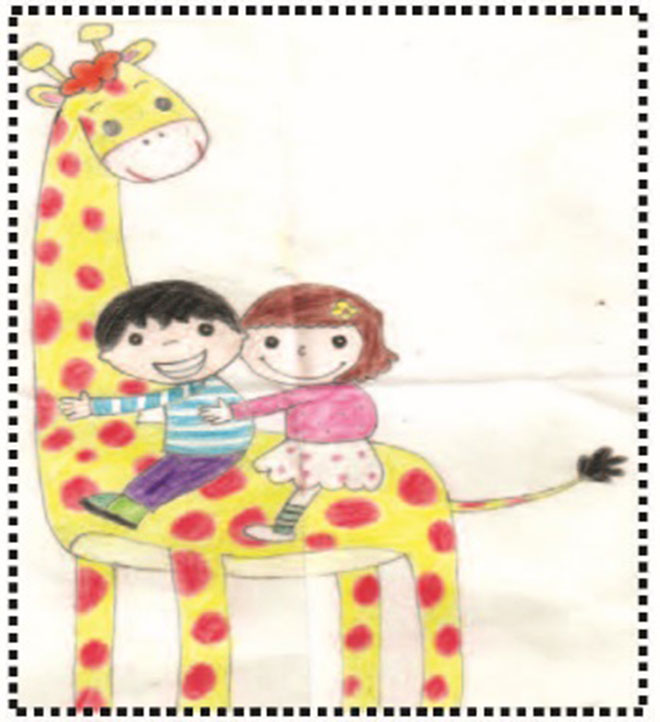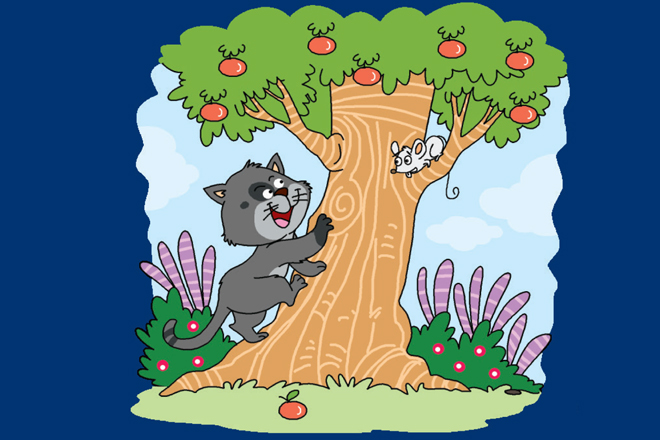
Author: rgsind


Spot the difference #2
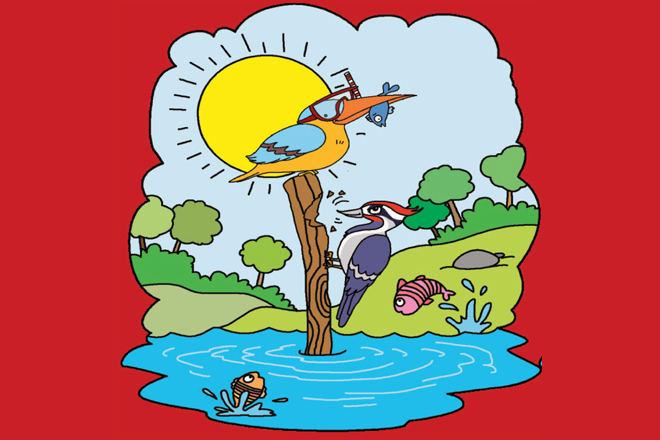
Spot the difference #1
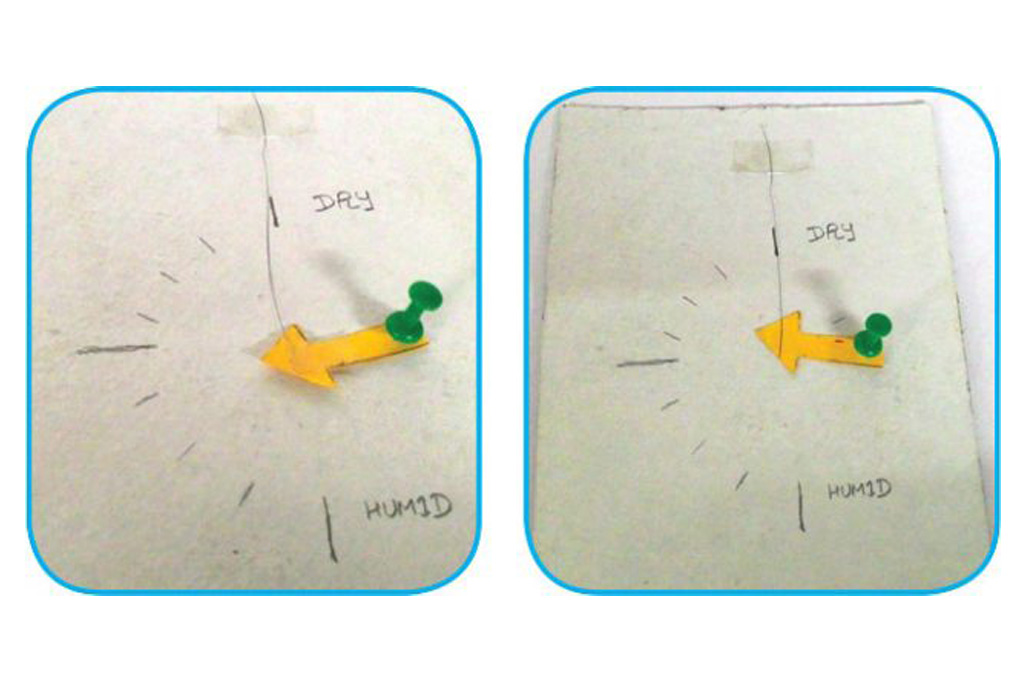
A Simple Hygrometer
Stuff:
• Chart paper,
• A rectangular piece of cardboard,
• A tack or notice board pin,
• A strand of human hair (clean and dry; not oily),
• A pencil,
• Scissors
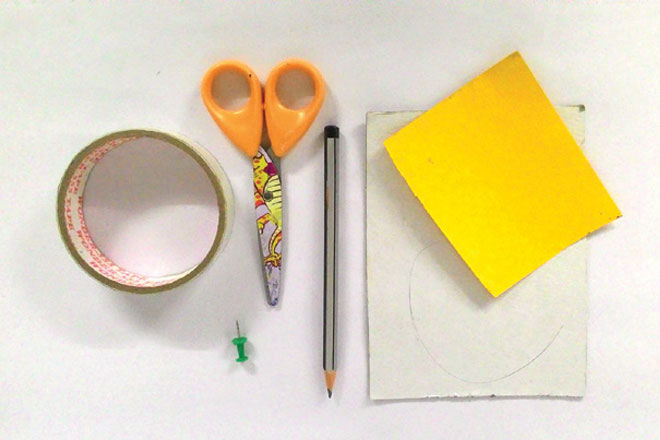
Do:
1. Draw an arrow on the chart paper and cut it out.
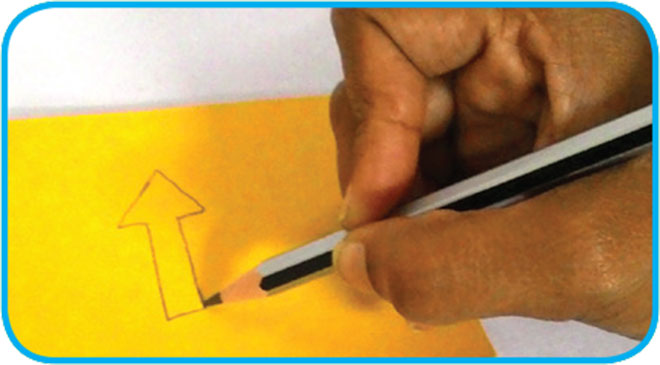
2. Pierce the arrow with the pin and make sure it can rotate freely around the pin. Pin the arrow to the board loosely so that the arrow swings down.
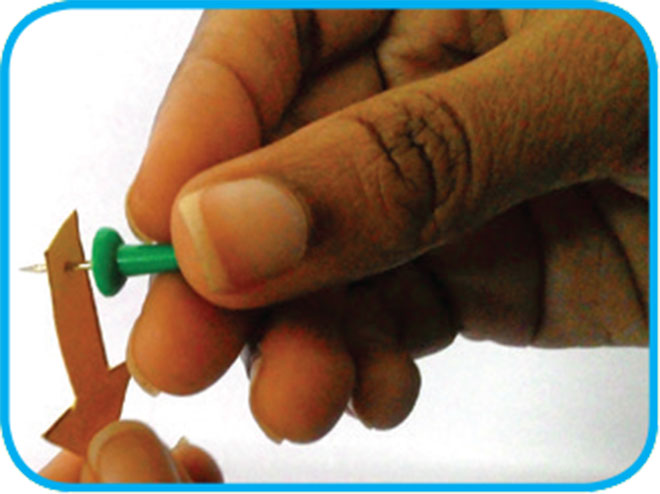
3. Tape one end of the strand of hair to the board and the other end to the arrow so that the arrowhead is horizontal as shown.
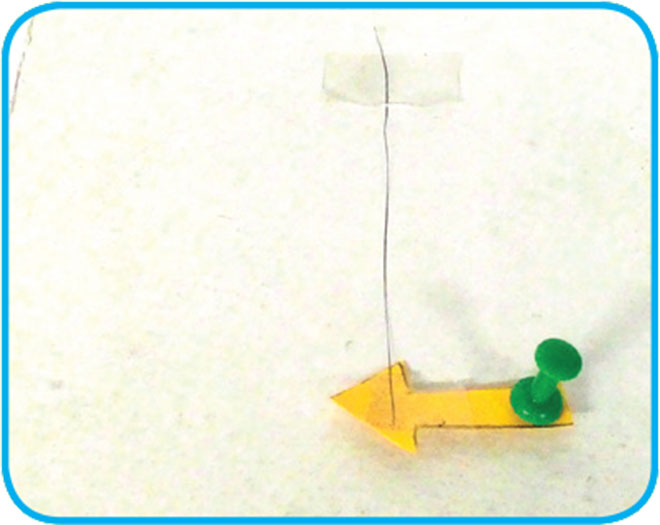
4. Draw some markings on the board near the arrow head: the indicator above the arrow should be marked ‘DRY’ and the one below should be marked ‘HUMID’.
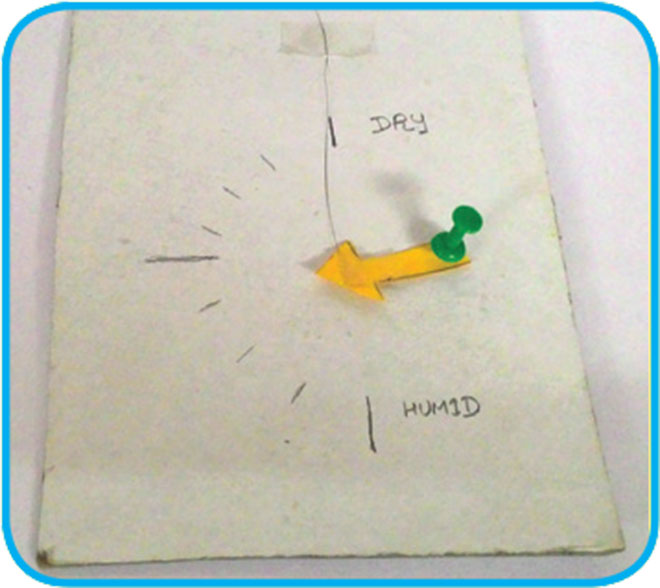
SEE:
When the air is humid, the arrow moves down towards ‘HUMID’. And when the air is drier, the arrow moves towards ‘DRY’.
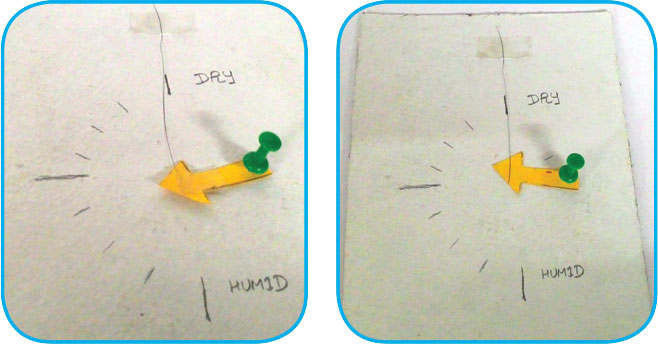
Think About
How does the simple hygrometer work?
Hair has the property to expand when wet and shrink when dry. Hair fibre can absorb more than 30 percent of its own weight in water, which makes it heavier and longer. So when there is more moisture in the air, the hair taped to the arrow absorbs the water and expands, which makes the arrow point down. And when the air becomes dry, the hair loses the water and shrinks, pulling the arrow up along with it.
Why do we measure humidity?
Humidity refers to the amount of water vapour in the air. Water vapour—from water on land and in the oceans—is a key greenhouse gas, which helps block harmful UV rays from the sun. It also traps heat on Earth that makes life on Earth possible. But too much water vapour, or high humidity, will cause Earth to heat up more, making hot days seem hotter. Therefore, measuring humidity, along with temperature, gives us an idea of the weather. The first ever hygrometer-like device was invented by Leonardo da Vinci in 1480. But the first working modern hygrometer was created by Johann Heinrich Lambert in 1755. Since then, different types of hygrometers that have been invented that measure humidity based on temperature, pressure or a mechanical or electrical change within the meter.
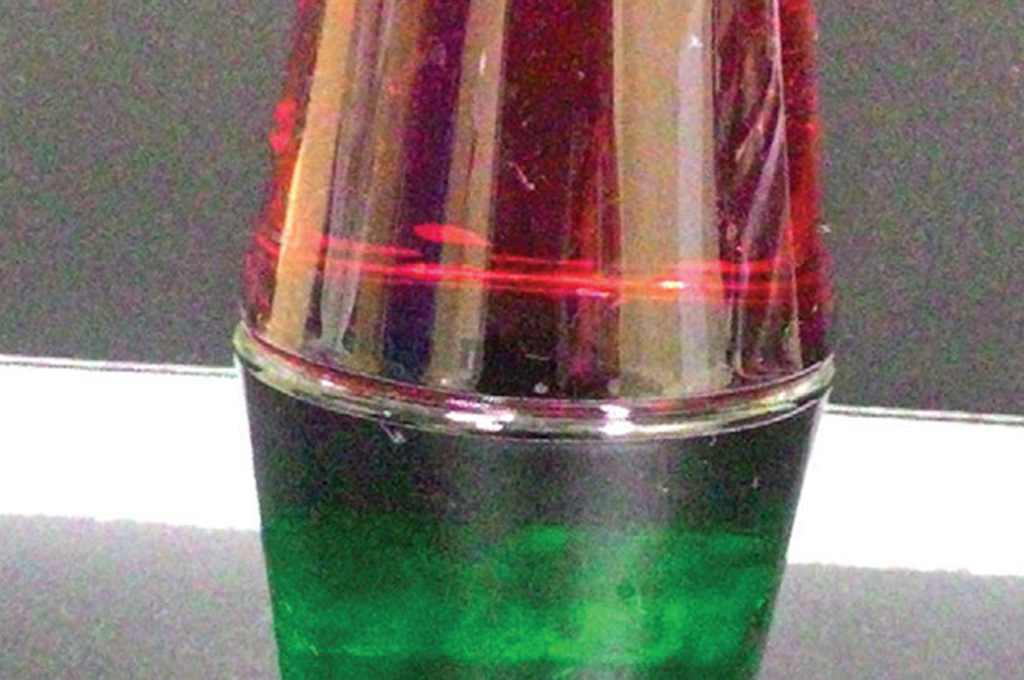
The Amazing Water Trick
Stuff:
• Two identical glasses,
• Hot and cold water,
• Food colours,
• Small sheet of plastic or thick paper cards
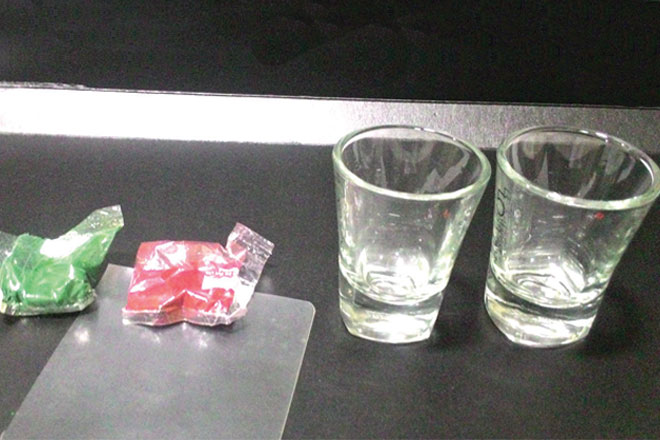
Do:
Fill both glasses to the brim with cold water.
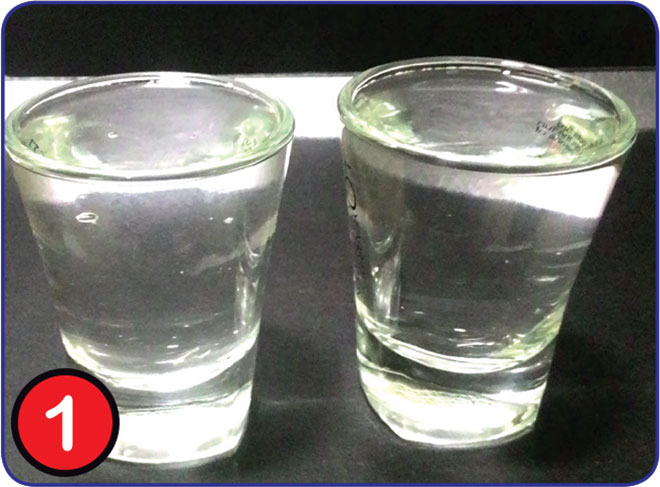
Add red food colour in one and green in the other.
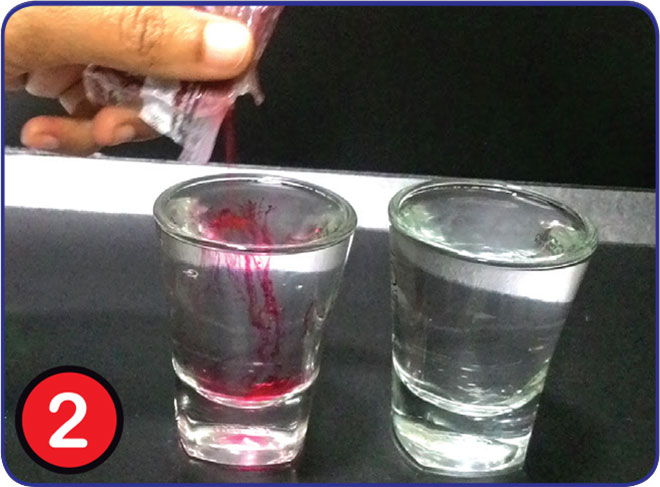
Cover the glass with red water with a plastic sheet. It should completely cover the opening of the glass.
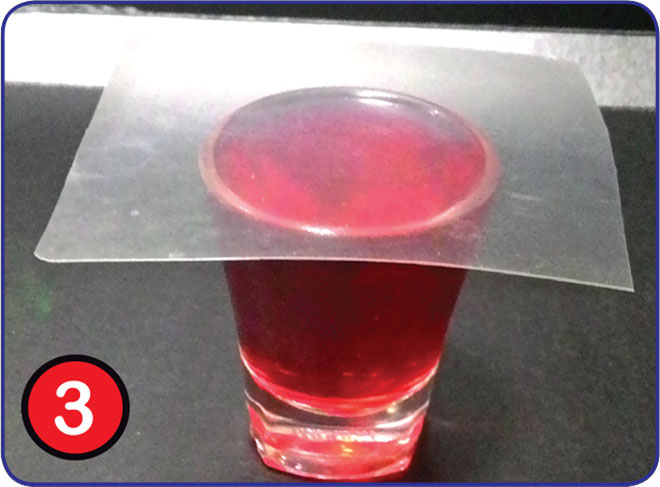
While pressing down along the rim of the glass, quickly turn it upside down. The plastic sheet will hold the water in place.
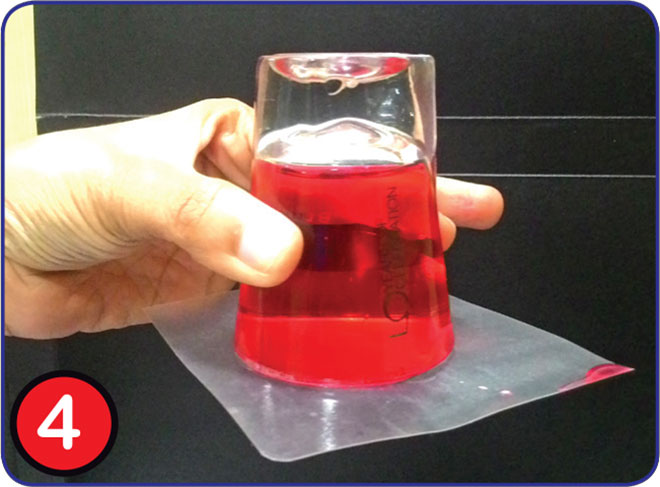
Place the upside-down red water glass over the green water glass. The rims of both the glasses should align perfectly.
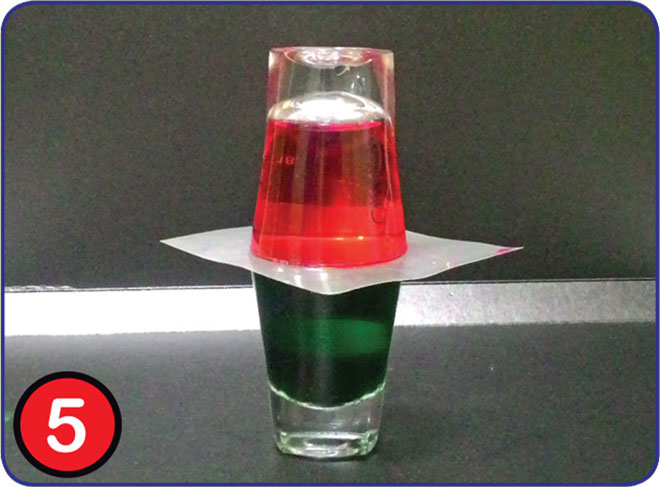
Now slowly pull the plastic sheet out.
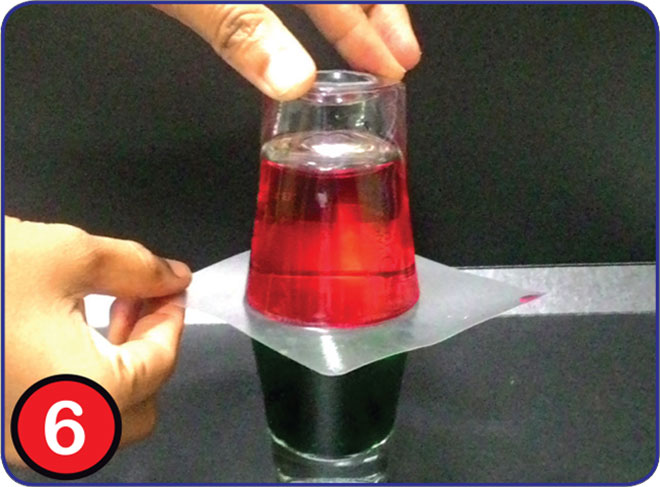
You will see the two colours mixing with each other.
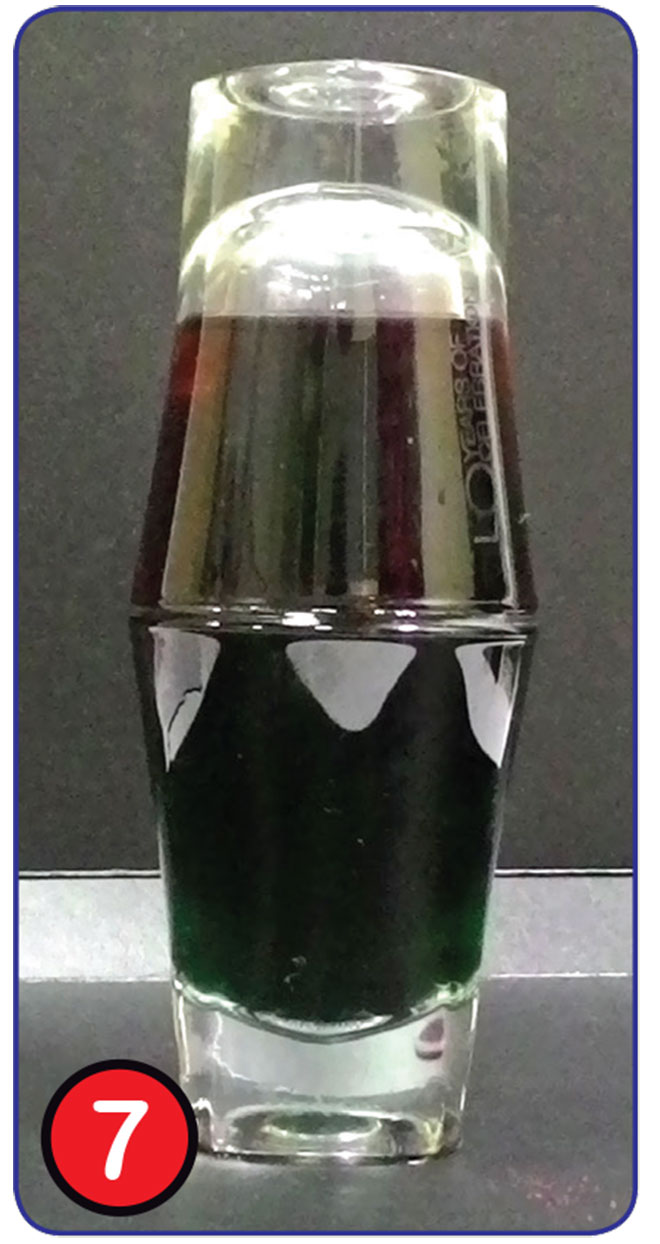
Now repeat the experiment, but this time fill one glass with hot water (red) under adult supervision, and the other with cold water (green). Repeat steps 2-6 and see what happens.
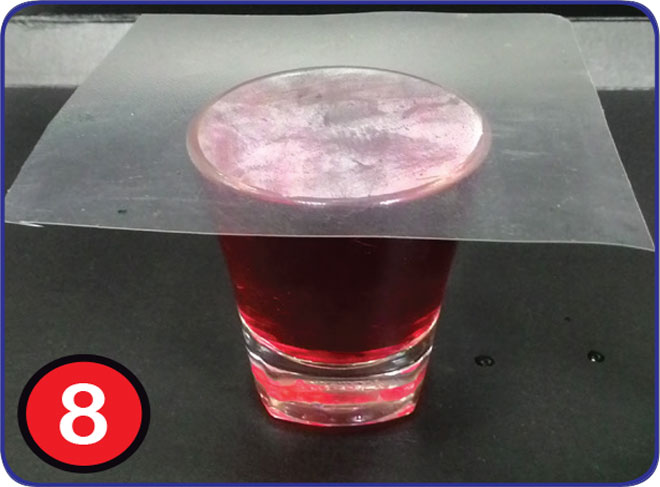
SEE:
Even though the plastic sheet is pulled out from between the glasses, the two colours do not mix. The red water stays on top, while the green water stays at the bottom.
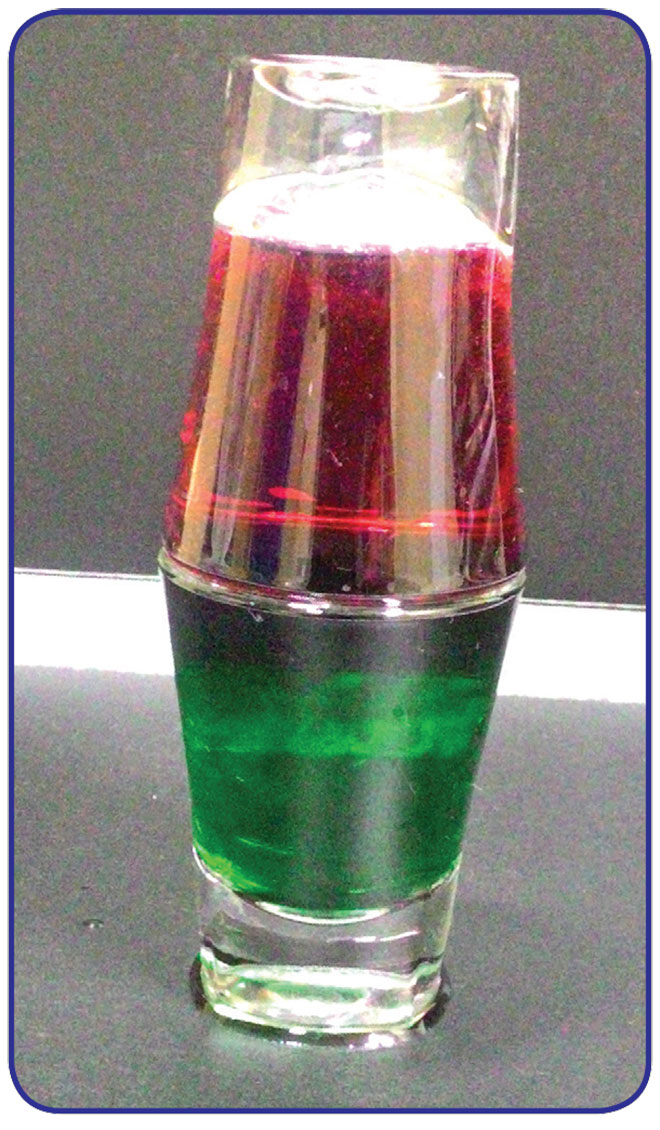
Think About
Why didn’t the coloured water mix with each other the second time?
When water is heated, the water particles (molecules) start moving around faster. They bounce off each other and move further apart, creating more distance between them. Because there is more distance between the particles (molecules), there are less of them in a given volume of water, as compared to particles (molecules) of cold water in the same amount of water. This makes hot water less dense or lighter than cold water.
So, when you put the hot, red-coloured water glass on top of the cold, greencoloured water glass, the colours did not mix because the hot water, being lighter,stayed on top and the denser cold water stayed at the bottom.
Let’s Find out
How do water heaters work?
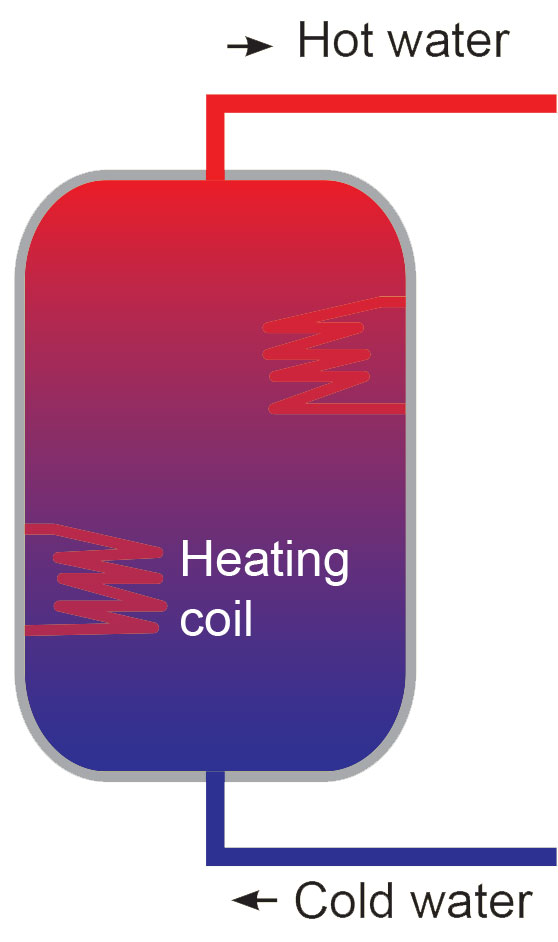
The water heaters installed in our bathrooms work on the same principle as our experiment. Inside a water heater, the cold water comes in through a pipe connected to the bottom of the heater. As water keeps flowing inside, the heating coil inside heats the water. The water that is heated up moves to the top of the heater as it becomes less dense while the denser cold water stays at the bottom till it heats up too. At the top of the water heater, there is another pipe connecting to the taps and shower through which the hot water comes out.
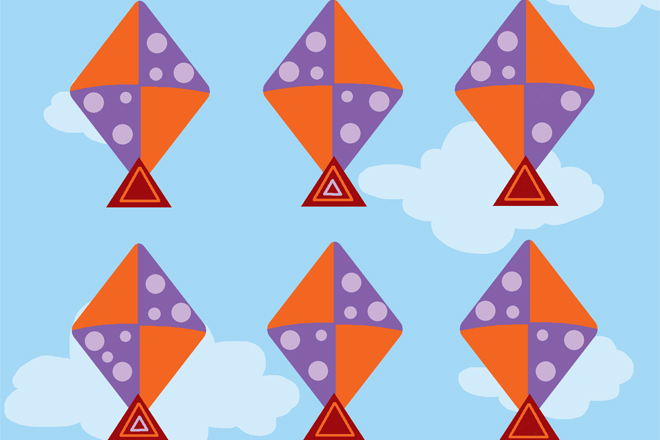
Kite Patterns
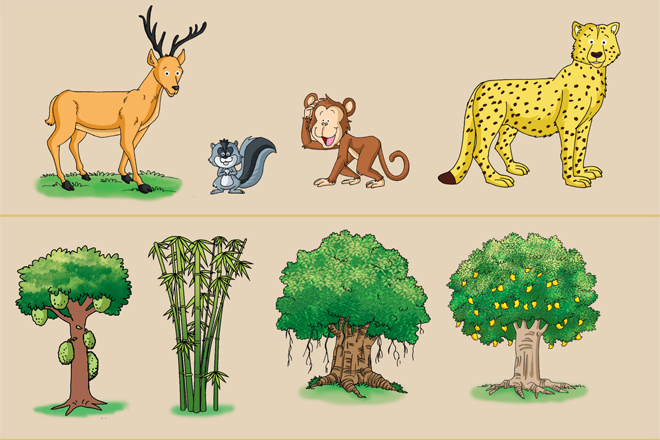
Trees Special
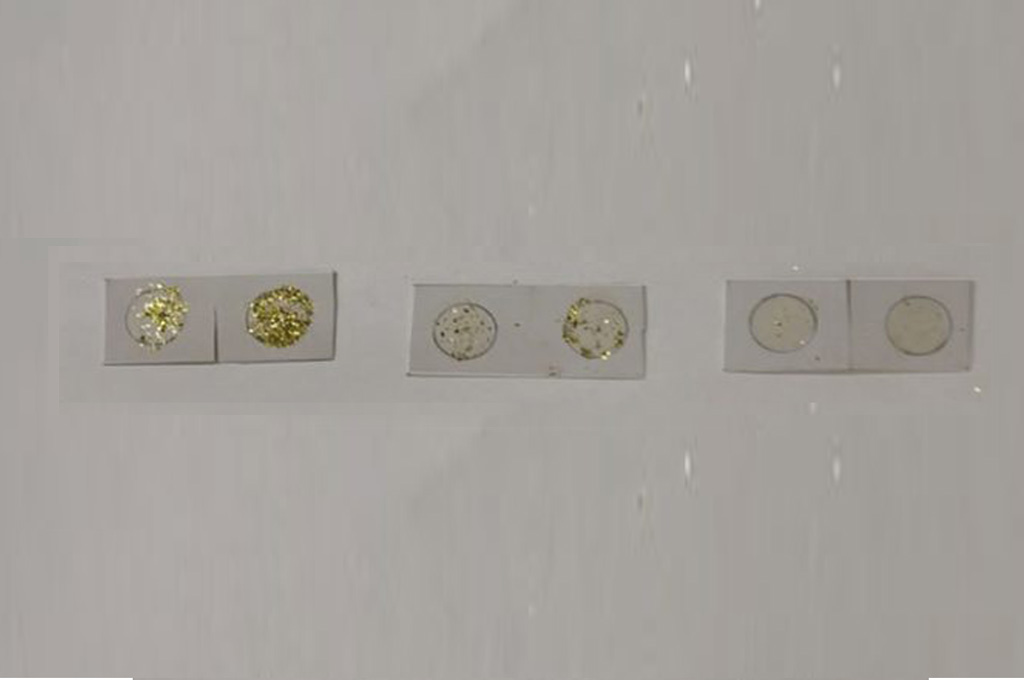
Catching Stardust
Stuff:
• Thin sheet of cardboard,
• Any petroleum jelly like,
• Vaseline gel,
• Glitter dust/ sand/ chalk powder,
• String, Rubber ball,
• Scale,
• Pencil,
• Scissors
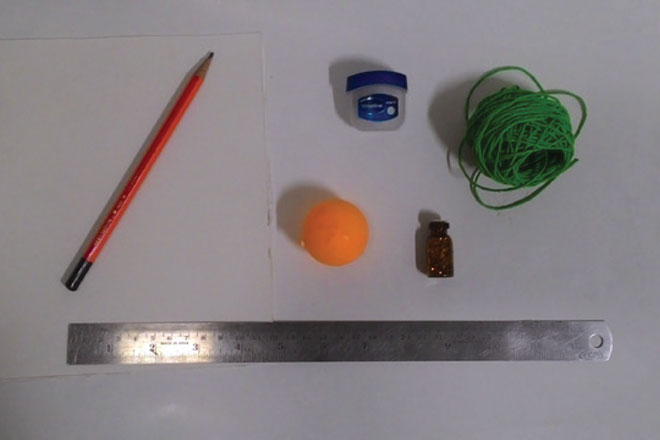
Do:
1. From the cardboard, cut 6 rectangles of equal size (3 x 1.5 inches). Draw two circles on each rectangle as shown.
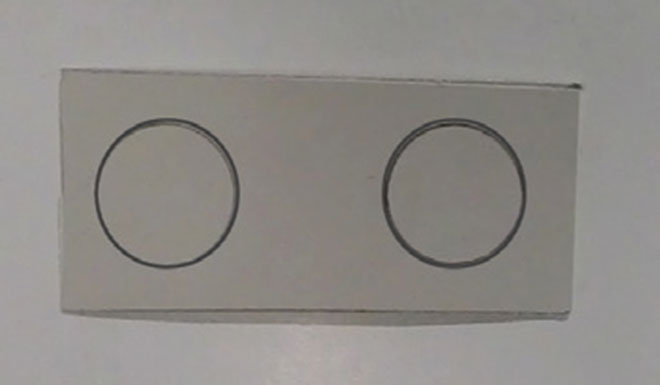
2. Using scissors, make a slit in the centre of each rectangular sheet.
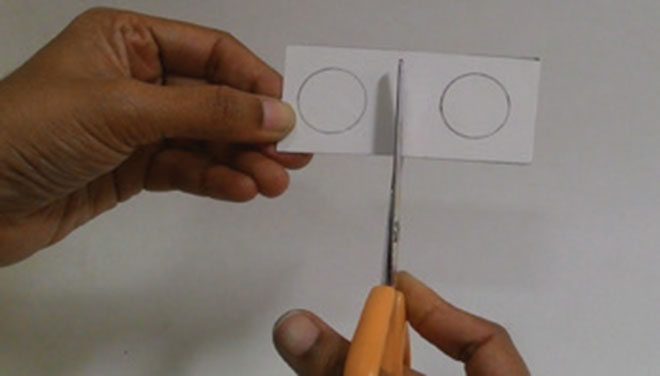
3. Fix two sheets at the slit as shown to form your satellite. Make two more. Smear petroleum jelly on the circles.
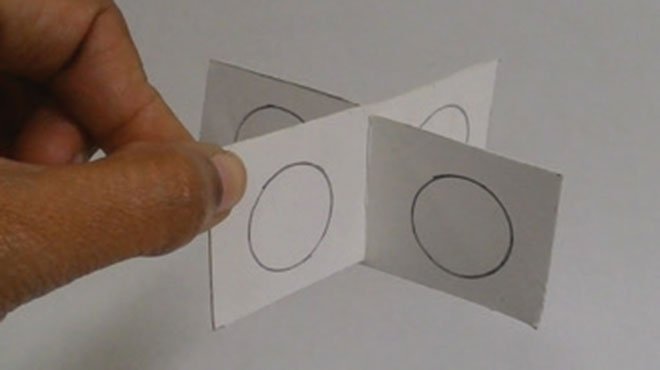
4. Take three pieces of string of different lengths—5, 10 and 15 inches. Attach one end of the string to a satellite and the other to the scale as shown. Suspend the satellites over a pile of glitter dust or fine sand and throw the ball into the pile.
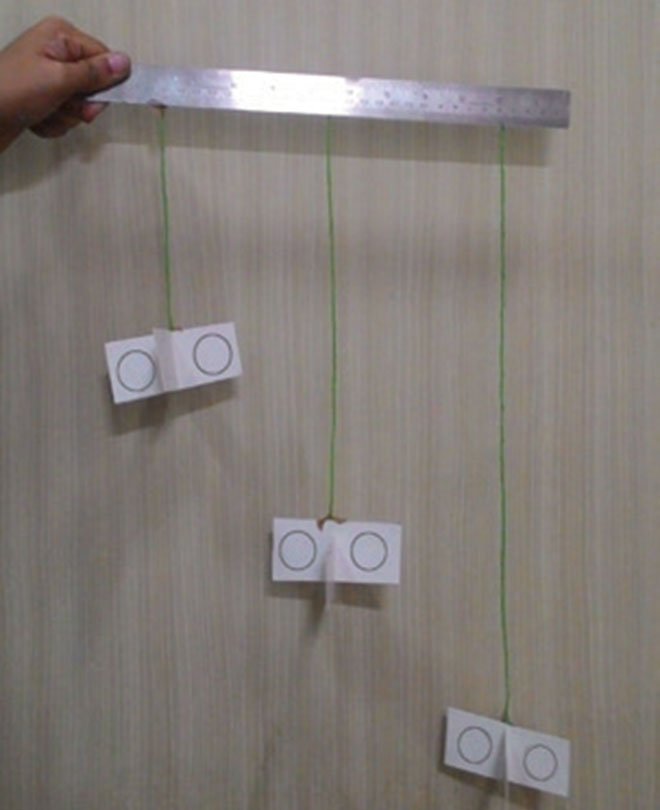
See
When you throw the ball into the pile of glitter or sand, it sends up a cloud of dust which is collected by your satellites, the amount varying according to their distance from the pile.

Think About
How do our “satellites” collect dust?
The cardboard cutouts and the strings attached to the scale simulate the satellites and their orbits. Their distance from the pile of glitter dust represents their different orbits around the comet. The impact of the ball on the glitter dust represents the dust cloud that results from a meteor impact. When we throw a ball on the pile of glitter dust, it scatters and the glitter particles are stuck to the “satellites” because of the petroleum jelly smeared on their surface. Besides studying the dust, scientists would also be able to calculate the distance of the satellite to the comet by analysing the amount of dust collected and the distance between the particles as would be evident in our cardboard satellites.
Let’s Find Out
How does an actual satellite collect stardust?
NASA launched the StarDust Mission satellite in 1999 to fly along the orbit of the comet Wild 2, and collect dust from it. The satellite was designed with a special collector plates filled with a special type of gel called aerogel that could trap the particles as they came in contact with it. When the satellite returned the stardust samples to Earth 7 years later in 2006, the trace of each particle could be seen in the aerogel. Each single particle was cut out of the gel and examined. One of the finds revealed the presence of amino acid glycine, one of the building blocks of life.
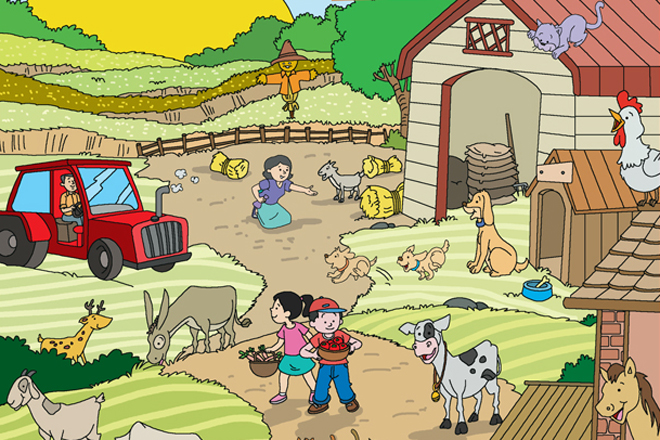
Farm
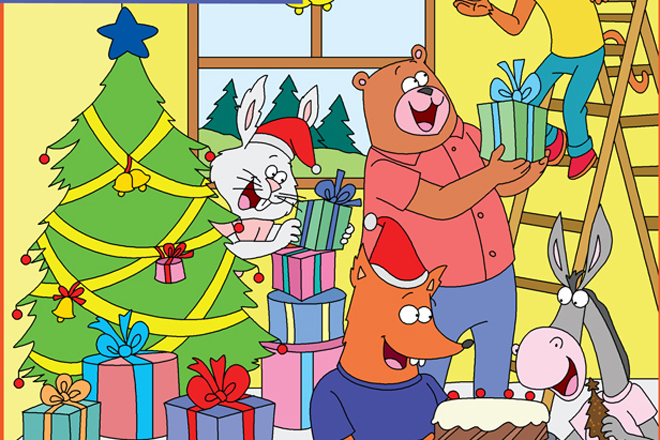
Christmas Party

Bus Ride
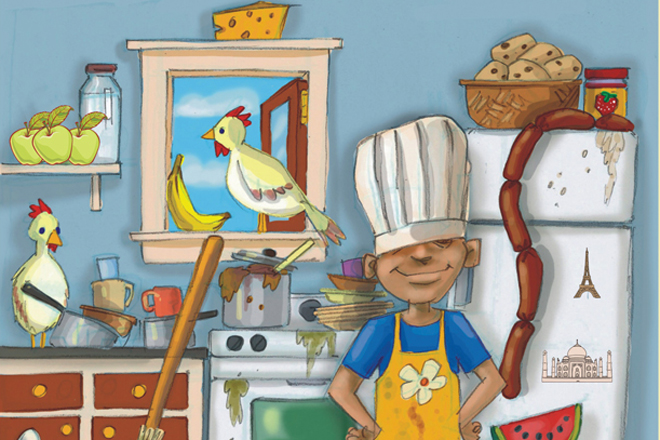
Kitchen
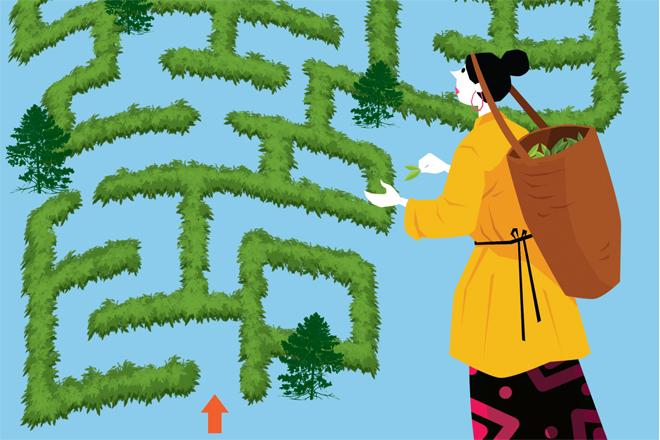
Tea Trouble

Public Transportation in India
A majority of Indians use public transport like buses and trainsto get from one place to another. Here’s a look at some of the common modes of public transport.
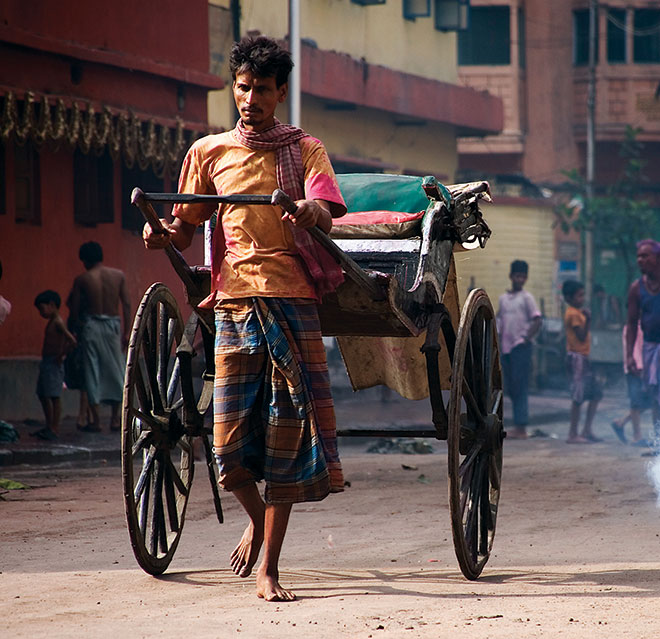
1. Hand rickshaws: The open hand rickshaw is meant for short rides. The passenger sits on a seat and the rickshaw is pulled by a person.Though this mode of transport has been called a human rights violation, they are still in use in Kolkata.

2. Cycle Rickshaws: An upgrade from the hand rickshaws, this tricycle-like vehicle is manned by a cyclist
and can carry one or two passengers over short distances. They are banned in several cities for causing traffic congestion. They can still be seen in some old parts of cities such as Delhi and Chennai.

3. Buses: Buses make up 90 percent of public transport in Indian cities. There are different types of buses such as double-decker buses, low-floor buses and air-conditioned buses.
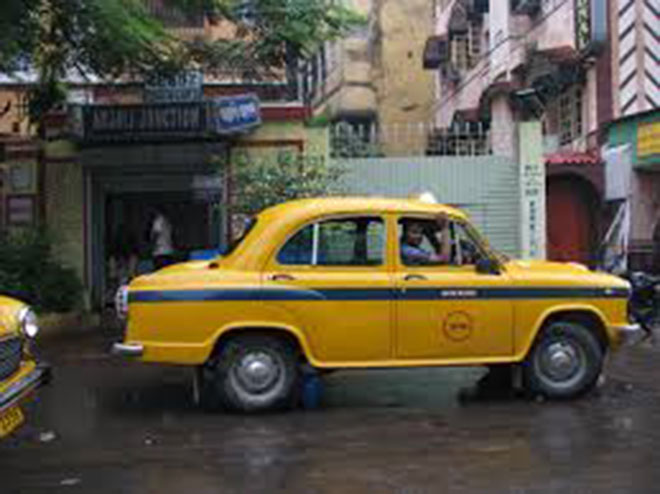
4. Taxis: Traditionally, taxis have looked like bumblebees because they were required to be coloured yellow and black. There was a time in cities such as Mumbai and Kolkata, when taxis could be hailed on the road. Now several taxis can be booked through the Internet using applications. Life has become quicker and easier!

5. Trains:The first ever railway line in India was opened in the year 1853 from Mumbai to Thane and ran a distance of 33.8 kilometres. Today, the Indian railways is one of the world’s largest railway networks. There are two different kinds of trains across India: suburban and long distance. Urban Mass Rapid Transit is a modern rail transport system used to get around the city quickly. Named as Metro, it was first started in 1984 in Kolkata. Today, Delhi, Bengaluru and Chennai have functional metros.

6. Airplanes: Civil aviation in India began on 18 February, 1911, when the first commercial flight took off from Allahabad for Naini in Uttar Pradesh. On October 15, 1932, J. R. D. Tata flew from Karachi to Juhu Airport. His airline later became Air India. Today, several private and government-owned aeroplanes fly the sky.

7. Ships: Shipping plays an important role in India’s economy. Approximately, 90 percent of the country’s trade by volume (70 percent in terms of value) is moved by sea. One can enjoy a ship journey to Andaman from any of the connecting ports of India such as Chennai or Kolkata.

8. Ferries and Waterways: These are unique modes of transport often seen in coastal areasand backwaters. These mini ships work like a mobile bridge,connectingtwo regions separated by water bodies. People andtransportvehicles such as buses, trucks and bikes are loaded on ferries and sailed to the destination. A ferry ride is possible in Goa, Maharashtra, West Bengal, Assam and Kerala.
9. Auto rickshaws: They are a common mode of public transport in India. They are unique to parts of South East Asia and Africa. It is a fun way to zip around the city in a jiffy.
Funky auto rickshaw names around the world:
Pakistan: Rickshaw
Jakarta, Indonesia:Bajay, bajaj or bemo
Sri Lanka:Tuk-tuk
Thailand: Samosa, tempo, tuk-tuk
Photo credits: www.commons.wikimedia.org

Why does my cat shed his claws?
When you see a claw lying around the house, there is no need for alarm. Cats shed claws regularly. It’s a natural process that takes place every two to three months. Claws are essential for cats and other members of the cat family, as they use them for defense, climbing and hunting. As the older, outer layer of the claw gets worn out, it is shed, revealing a newer, sharper claw. You can help your cat by making sure there are plenty of options like a door mat or other rough surfaces where it can scratch to remove the older claw.
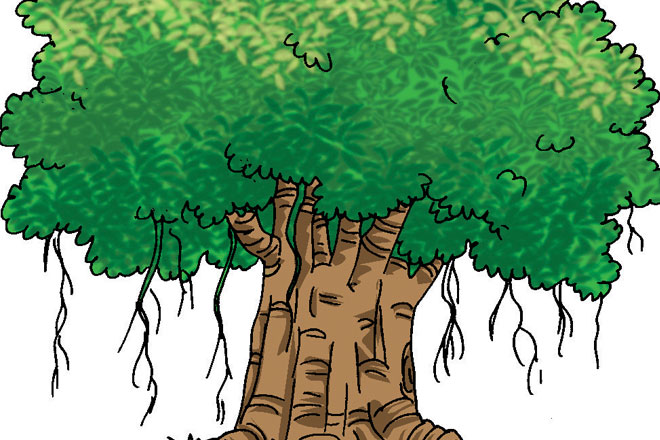
Do trees age like humans? How can we tell their age?
Yes. Like humans, trees do age but their lifespan varies for different species. One of the ways of finding out the age of a tree is by counting the rings within their branches and the trunks. These rings usually appear as alternating rings of dark and light shaded wood; you will need to count the number of dark rings to find out the tree’s age. For example, if a tree has 65 dark circles, it is 65 years old. These unique rings are known as growth rings. They are created every year when a new layer of wood is added to the branches and trunk of the tree. The light-coloured rings are known as the springwood and are generally wider in size because trees grow most during spring. The darker rings are known as summerwood and are relatively thinner because the growth of trees slows down during summer.
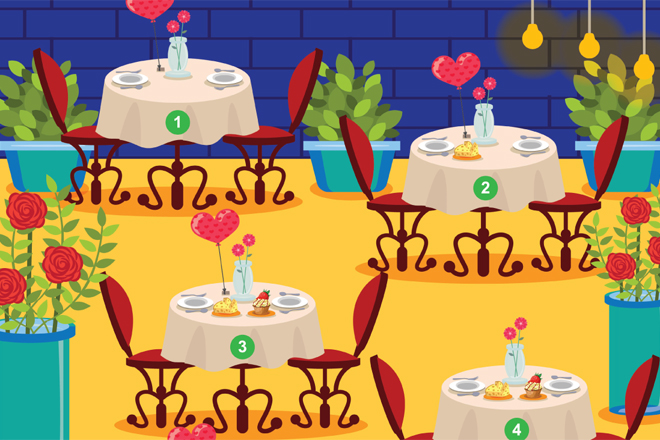
Dinner Date

Cake for Christmas
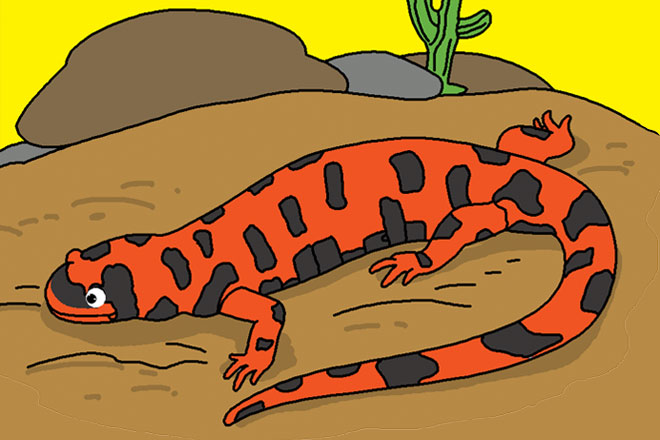
What are Gila monsters?
A. Gila monsters are a species of venomous lizard native to the United States and Mexico. They are heavy and slow-moving lizards that can grow up to 2 feet in length. Though the Gila monsters are venomous, owing to their sluggish nature, they pose little threat to humans. Their bite is painful but it is not fatal.
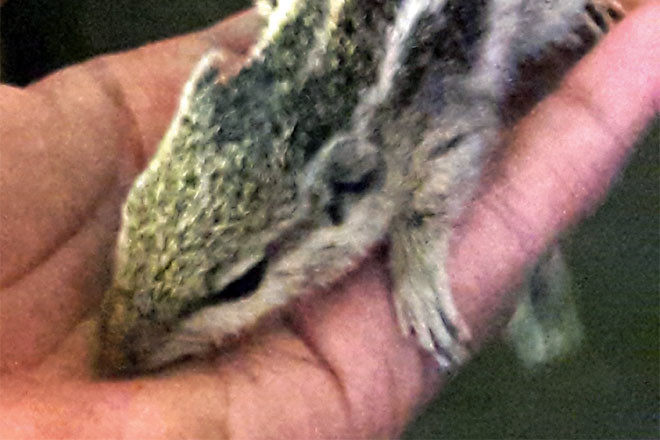
I adopted a pet baby squirrel that I found near my house. How do I take care of it?
If it’s a baby squirrel, it won’t be able to survive on its own. You need to nurse it till it’s four to five months old. It needs fruit juices and small bits of fruit and baby food. You can also prepare a juice for it at home by adding one teaspoon of salt and three teaspoons of sugar in one-fourth cup of lukewarm water. The baby squirrel has to be fed every hour. Also, since the baby can’t control its body temperature, you need to keep it in a box lined with thick, warm blanket, but do not cover the box with the lid. With your help, it will survive.
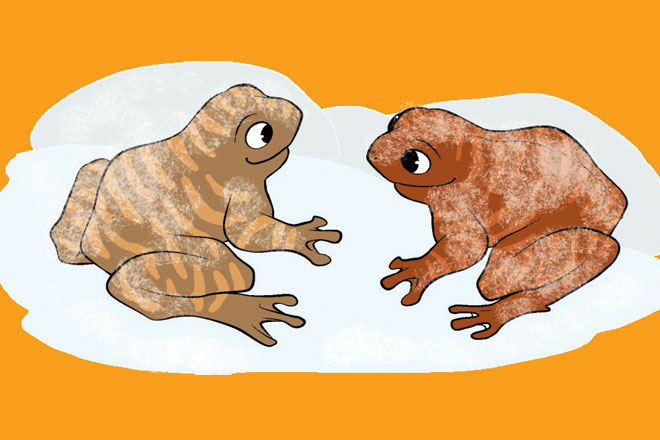
Wood Frog
During winter, our jackets and sweaters keep us warm. Sometimes, we light fires to stay warm. But unlike us, the wood frog freezes itself to escape the harsh winter.
The wood frog, found in North America, is known to freeze through winter. When the temperature drops below freezing point, the wood frog takes cover and starts the freezing process. Its organs pump water that fills up every little cavity in the body. Gradually, 65 percent of the water turns to ice. Subsequently, the frog’s breathing and heartbeat stop.
The frog has a substance in its body that lowers the freezing temperature of its tissues, preventing them from becoming completely frozen and eventually dying. During this frozen hibernation, the frog’s body temperature remains between -1°C and -6°C. The metabolism of the frog drops and this helps it survive the winter without food.
In a pond full of wood frog tadpoles, each tadpole has the ability to identify its siblings.
During spring, when it starts becoming warmer, the ice inside the frog’s body melts. The water flows back to the cells and blood starts flowing again. Slowly, the frog returns to its normal self.
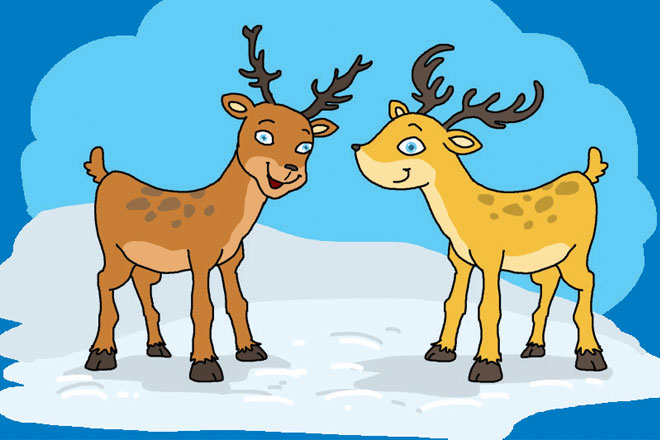
Reindeer
When it is dark, we strain our eyes to see better. Reindeer, though, simply change the colour of their eyes!
Reindeer live in the cold Arctic regions and can be found in the northern parts of Europe, Asia, North America and Greenland. From November to February, the temperature in the Arctic regions can drop below -50 degree Celsius. During these months, on most days, the sun does not rise at all, hence, it is always dark which makes it difficult for animals to see. Also, snow reflects ultraviolet light a type of light that is invisible and harmful to the human eye.
When it is dark, our pupils dilate, that is, become bigger, to allow more light to enter the eyes. Similarly, the reindeer’s eyes remain dilated throughout winter as it is always dark. Hence, there’s continuous pressure on the tissue (called tapetum lucidum) in its eyes which changes the way the eyes reflect light. Because of this change, the eyes turn blue and the reindeer is able to see well in the dark.
However, the reindeer can see the ultraviolet light as its eyes change colour from golden to blue.
This helps them to navigate their way around, find food and spot predators.
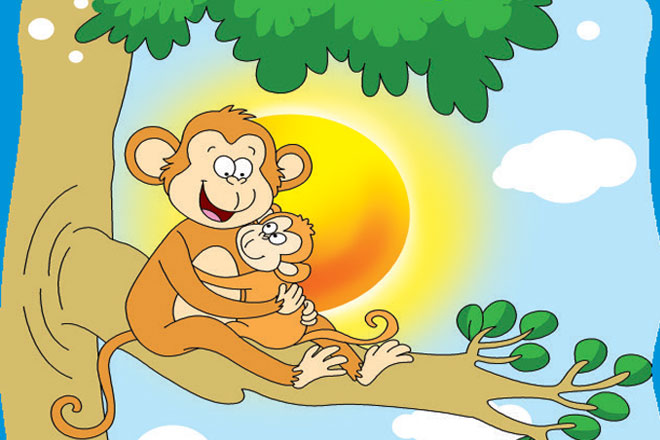
Macaque
Noticed how when some adults talk to babies, it usually sounds like they’re speaking gibberish? There is actually a word for it-motherese.
It is a term that describes the way a mother or any adult, talks to young children. Babies, who still haven’t learnt a language or cannot distinguish words, can understand when their mother uses different tones and volumes to convey different meanings. This could be a warning to not touch something or an encouragement to try something new
It has been discovered that humans are not the only species to use “baby talk”. Adult rhesus macaques talk to baby macaques in a language that is different from the one they use to communicate with other adults.
Rhesus macaques are a species of primates commonly found in India, Pakistan, Nepal, Afghanistan and China. When an adult female rhesus macaque is around an infant that is not her own, she makes high-pitched sing-song sounds that are called girney to communicate with the baby macaque and establish a friendly contact. They also “girney” to attract the attention of a baby macaque which wanders away from its mother so as to make sure it doesn’t wander beyond the territory.
A female macaque does not use the girney with her own offspring. And when she does girney with another baby macaque, she will also wag her tail simultaneously.
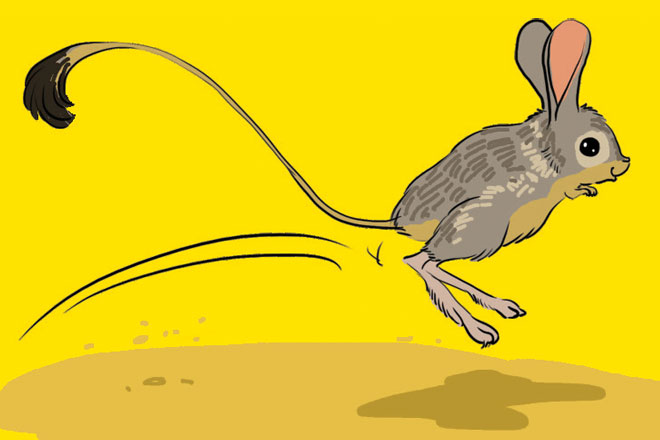
Jeroba
Jerboa is a small mouse-like mammal mostly found in the deserts of Asia and Middle East, and feeds on small insects and plants. Its rabbit like ears, kangaroo like hind legs and disproportionately long tail—features that help it survive the harsh desert conditions—make it look distinct from its rodent cousins.
The jerboa’s hind legs, which are four times longer than its front legs, help it move across the desert by jumping. It can jump up to a distance of 10 feet, both vertically and horizontally. And the hair on its hind legs prevents its feet from sinking into the loose sand.
Its forelegs, which are much shorter, are designed for digging burrows where it stores food.
A jerboa’s long tail gives the animal balance and support when standing on its hind legs. Because of these features, it looks and sprints like a kangaroo.
During World War II, a division of the British Army used the jerboa as its mascot.
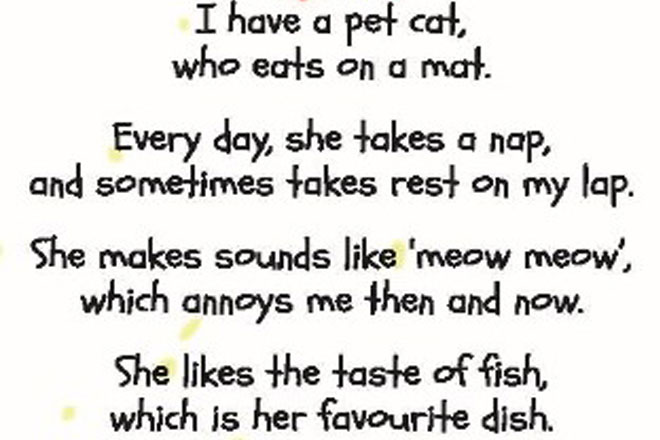
My Cat
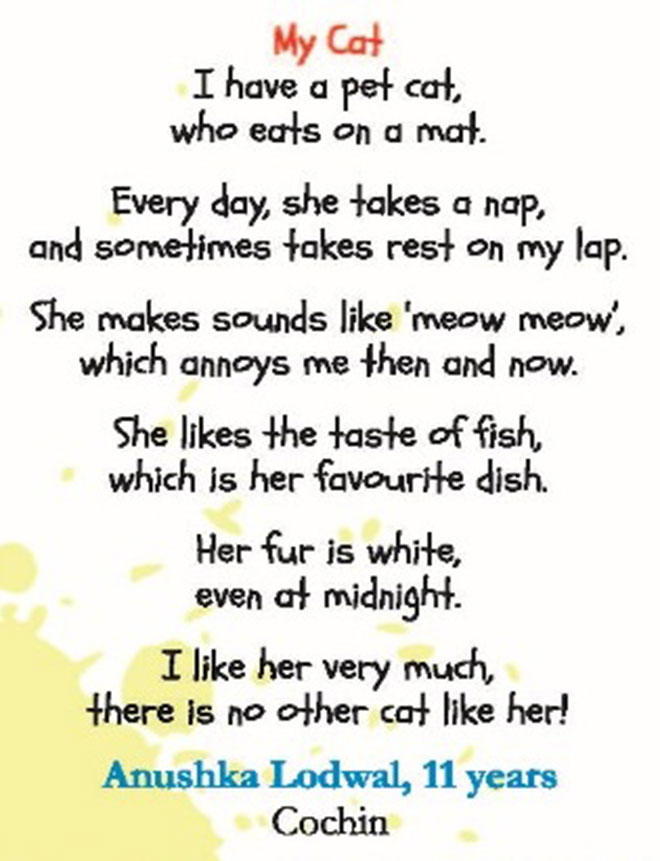
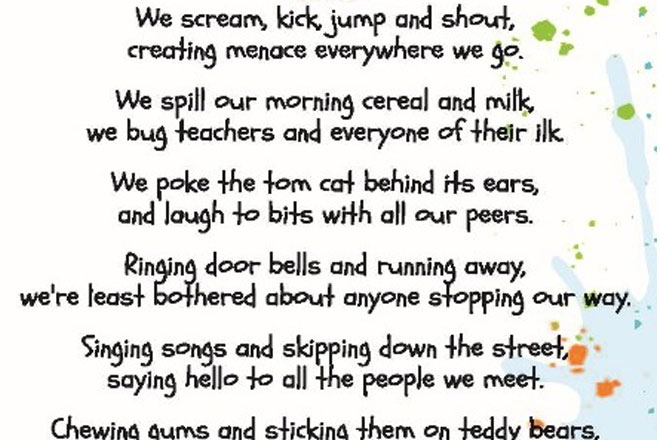
Child
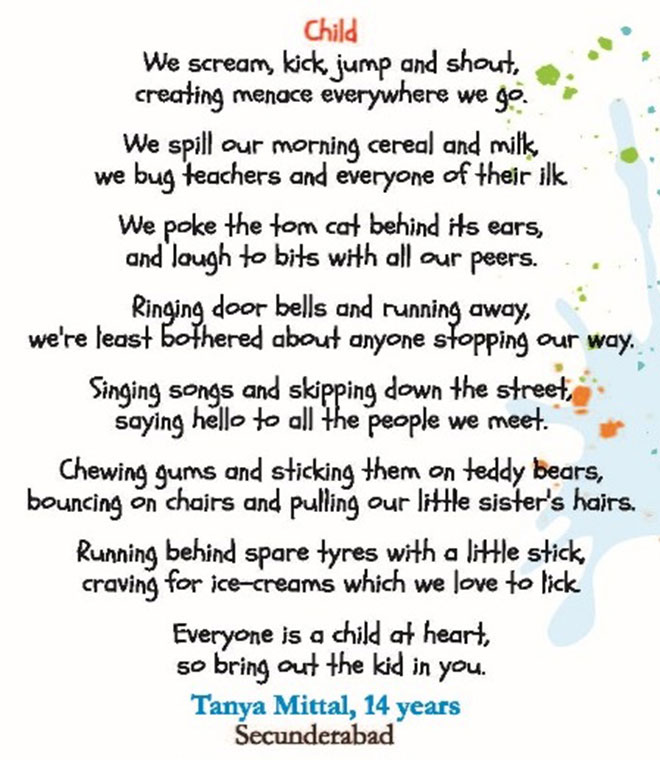
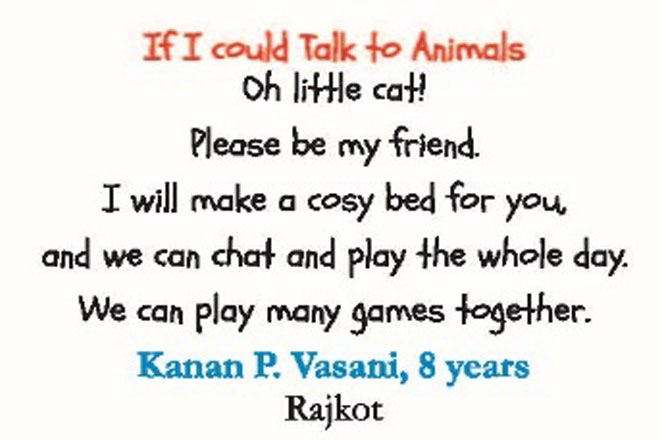
If I could Talk to Animals
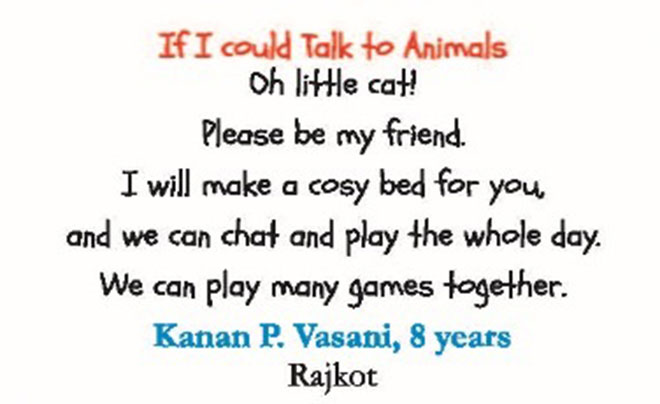

My Dad

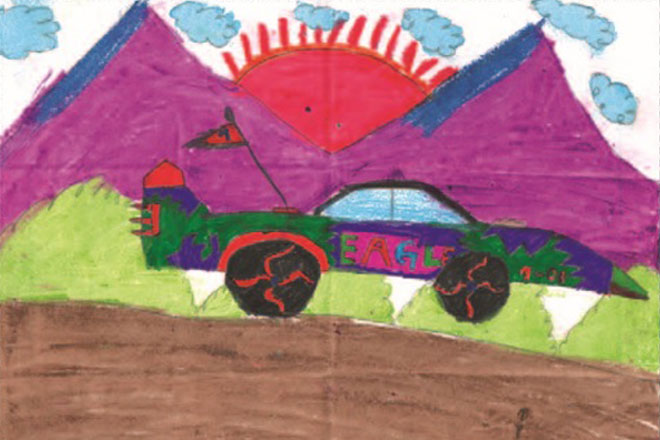
A. S. Abhiram
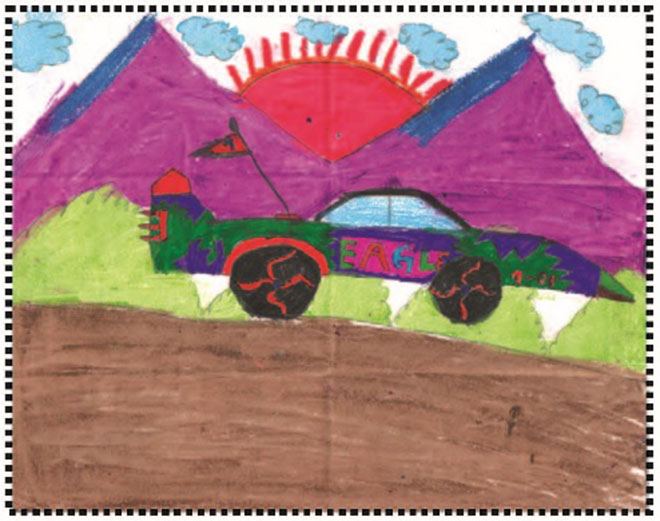
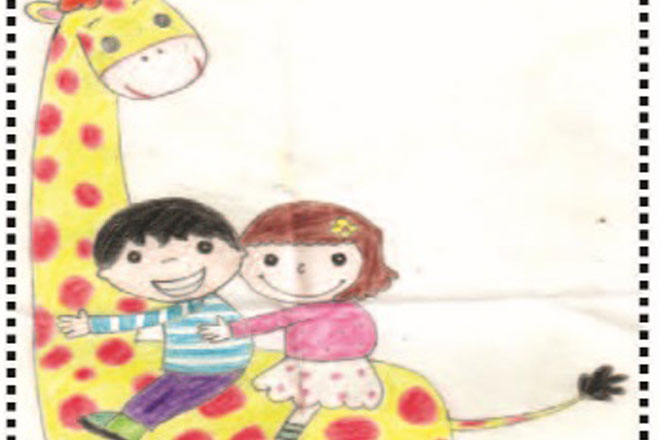
Anu Prajna
